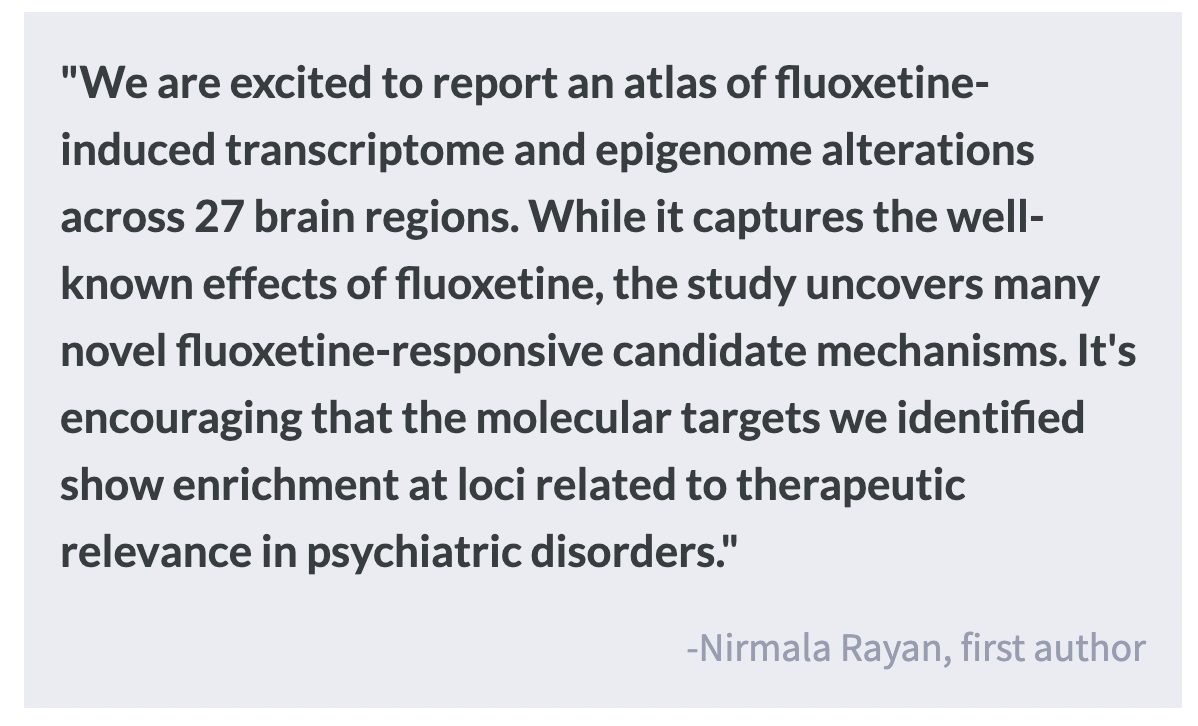The Impact of SSRI Fluoxetine on the Transcriptome and Epigenome
Post by Leanna Kalinowski
The takeaway
The molecular effects of chronic selective serotonin reuptake inhibitor (SSRI) treatment on the brain are not well understood. This research shows that fluoexetine - an SSRI - induces widespread gene expression changes and epigenetic modifications in brain regions known to play a role in depression.
What's the science?
Depression is a common and serious mood disorder that causes persistent feelings of sadness, hopelessness, and emptiness. Despite SSRIs being the most prescribed medication for depression, they are not effective for everyone and often have negative side effects.
Another major hurdle in the development of new antidepressants is that the mechanism of action of SSRIs is not fully understood. While the clinical benefits of SSRIs were initially attributed to blocking serotonin reuptake (leaving more serotonin in the brain), additional mechanisms have since been proposed (e.g., adult neurogenesis & synaptic plasticity). Further, the gene regulatory changes induced by SSRIs are not well understood. To develop better treatments for depression, it is important to fully understand the molecular mechanisms that underlie SSRI action. This week in Molecular Psychiatry, Rayan and colleagues used transcriptomic and epigenomic techniques to map the molecular mechanisms of fluoxetine, a widely used SSRI.
How did they do it?
Adult male rats were separated into two groups: the treatment group received daily fluoxetine in their drinking water, while the control group received plain drinking water. Following six weeks of treatment, 27 distinct brain regions were harvested and underwent bulk RNA-sequencing and ChIP-sequencing. Two hippocampal regions were profiled at a finer resolution using single-cell RNA-sequencing.
Bulk RNA-sequencing (RNA-seq) is a technique that measures the expression of genes across the transcriptome, which is a collection of all the gene readouts present in a cell. Rather than pre-selecting a handful of candidate genes, RNA-seq allows for a comprehensive look into how fluoxetine impacts gene expression across the brain. Single-cell RNA-sequencing (scRNA-seq) is similar, but instead measures the expression of genes at the level of individual cells rather than collectively across all cells. ChIP-sequencing (ChIP-seq) is a technique that maps out where proteins bind to DNA in the brain. In this study, the authors were interested in mapping H3K27ac, which is a marker of histone acetylation (i.e., an epigenetic modification that is associated with greater levels of gene transcription).
What did they find?
RNA-seq analysis revealed strong and widespread gene expression changes in rats chronically exposed to fluoxetine. Specifically, differences in gene expression between groups were most pronounced in the raphe nucleus, nucleus accumbens core and shell, arcuate nucleus, and locus coeruleus. These brain regions have previously been implicated in monoaminergic (e.g., dopamine, serotonin) action, which supports our previous knowledge that fluoxetine modulates monoaminergic signaling. A similar pattern was observed with the ChIP-seq data, where the authors found stark histone acetylation (a DNA modification that affects gene expression) differences associated with chronic fluoxetine exposure. Notably, the raphe, nucleus accumbens shell, dorsal hippocampus, nucleus accumbens core, and locus coeruleus had the greatest differences in both gene expression and histone acetylation. In addition to the above regions, the study reports diverse effects of fluoxetine in 22 other brain areas, many of which have not been previously studied. Fluoxetine altered as many as 4447 transcripts and 4511 genomic loci in at least one brain region. scRNA-seq revealed that the hippocampal cell types most impacted by fluoxetine treatment are inhibitory neurons, mossy cells, and subtypes of glial cells, which have all previously been implicated in anxiety and depression.
What's the impact?
This study was the first of its kind to map the transcriptomic and epigenomic landscape of chronic fluoxetine administration in the brain. This research identified candidate genes, pathways, and cell types that can be further explored, in the hopes of identifying pathways that could be targeted for future antidepressant development. Given that there are stark sex differences in the prevalence of depression and the efficacy of SSRIs, future studies of this nature should also incorporate female subjects.


